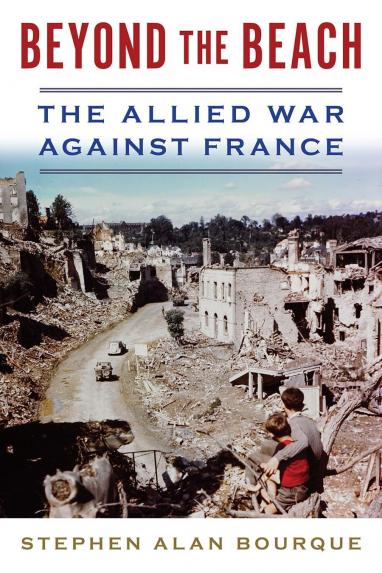
Beyond the Beach: The Allied War against France. By Stephen A. Bourque. Naval Institute Press, Annapolis, 2018.
Reviewed by Gregory P. Gilbert
EFFECTS-BASED OPERATIONS remain a cornerstone of the modern Australian Defence Force approach to warfighting. For the mathematically inclined it has all the advantages of a binary (go/no-go) decision making process that leads to statistically guaranteed outcomes and concrete effects. Rote learning effects-based methodologies have tended to swamp operational planning and targeting processes to produce what appear to be achievable effects, however life is just not like that.
The truth is that warfare is a human activity which has an infinite number of possibilities and which tends to follow unpredictable models at least as often as it does predictable ones. ‘Beyond the Beach’ provides a classic example of the importance of human agency on the conduct of warfare and how those of us who wish to achieve certain effects are often blind to the actual results of our operations.
‘Beyond the Beach’ is a comprehensive study of the Allied air war against France in 1944. During this time some 60,000 French civilians were killed, many thousands injured and large segments of the population were traumatised, in what would today be considered collateral damage. At the time France was part of the Allied nations and many French people were fighting with the Allied Forces against the German occupiers. The conduct of the Allied air campaign against France in 1944, a friendly occupied state, culminated in a swath of human and physical destruction across northwest France. This was no accident the Allied senior commanders chose to destroy French civilian targets despite internal criticism from certain air component commanders and from various targeteers. The most important thing about this study is not that such destruction occurred but that it has remained largely outside the accepted narrative of the D-Day operations. By ignoring the human effects of the Allied air campaign upon their French Allies, the majority of British and American analysts and historians have suppressed the unpalatable truth of these operations. People who have studied the Allied air war against France in 1944 have described in detail how they obtained their desired strategic and tactical effects but have ignored the elephant in the room. Was it necessary to destroy segments of the French civilian population during the D-Day operations in 1944?
Stephen Bourque does not answer this question although his thorough research does make it clear that in many instances clear alternatives were available to the planners but the lives of their allies, the French civilian population, just did not count in most of their final assessments. After discussing the reasons behind the missing narrative of D-Day, Bourque explains how the D-Day operational planning evolved over time. The largely subconscious decision to ignore French civilian casualties was largely due to the logical thought processes that just did not emphasise such effects. Individual air campaign targeteers did often identify the likely collateral damage from specific raids but such considerations were largely hidden beneath the assumption that such casualties were necessary to win the war against Germany. Bourque then explains how General Eisenhower and his land component command colleagues saw the D-Day operations as essentially Army first activities. The Allied Air Forces were there to provide support to the land campaign, hence Eisenhower over-ruled the numerous objections of the Allied strategic air force commanders, Air Chief Marshal Arthur Harris and General Carl Spaatz, in order to ensure that the heavy bombers were used in support of the land campaign in France. The repercussions of this decision on the French population was disastrous and often resulted in little positive effects on the land campaign. For instance whereas approximately 5000 British, Canadian and American ground troops dies during the D-Day lodgement French civilians suffered about three times that number of deaths over the same period.
While Bourque leaves it very much to the reader to decide in what circumstances the French collateral damage was acceptable or not, ‘Beyond the Beach’ describes the many different types of air targets that were involved. It describes attacks on airfields and ports, on industry, against V1 and V2 missiles, on railways and transportation, on bridges, as part of the deception operations, in support of the landings and the destruction of French towns. In total the evidence is overwhelming. It was a very complicated war involving numerous targets and a vast multitude of aircrews, aircraft, weapons and specialist instruments. As such the main features of the Allied air war against France has many similarities with the planning and execution of modern military campaigns. Today civilian casualties amongst Allied populations are routinely minimised by Western armed forces, although the record of recent air campaigns conducted by Russian and Saudi Arabian air forces demonstrate that protection of civilians is not always a major concern to those planning targets. It also remains very difficult to confirm the number of civilian casualties that have resulted from air action in recent conflicts. How many civilians have died in Iraq and Syria due to Australian bombing? If we continue to ignore part of the actual effects then effects-based operations become meaningless. Perhaps the hidden narrative described by Bourque remains a fixture within Western militaries to this day.
‘Beyond the Beach’ is a very informative work which raises many questions that are relevant today. This book is recommended for air enthusiasts and joint force commanders alike.



